#Isothiocyanate
Link
1 note
·
View note
Text
When the tissue is damaged, the released myrosinase and glucosinolates mix, resulting in the irreversible production of an unstable aglycone, which then rearranges into a variety of biologically active compounds, mostly nitriles and isothiocyanates (Figure 23.14).
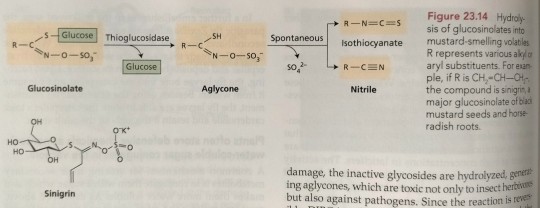
"Plant Physiology and Development" int'l 6e - Taiz, L., Zeiger, E., Møller, I.M., Murphy, A.
#book quotes#plant physiology and development#nonfiction#textbook#hydrolysis#mustard#volatiles#myrosinase#glucosinolate#unstable#aglycone#nitrile#isothiocyanate#sinigrin#black mustard#horseradish
0 notes
Text
Phenyl Isothiocyanate Manufacturing Plant Project Report 2023 Edition
Phenyl isothiocyanate, known by its abbreviation PITC, is an organic compound that forms a colorless-to-light-yellow liquid with a sharp, pungent odor.
0 notes
Text
cancel me for this but imo umami does not need to be brought into the english lexicon because it is literally just savory but mala does because there isnt a concise equivalent. im not saying numbing heat when i can say mala. its shorter. umami is not shorter than savory.
1 note
·
View note
Text
Fendom Mistress Pussy Fucking Lesbians
Watch me wank off my big tight and twitchy bare nobbed cock til I cumM
Naruto fuck Tayuya virgin tight pussy orgasm and creampied
nena linda
Amateur teen anal outdoor Petite, tattooed, and highly pretty, Gina
How I met my girlfriend Gina Valentina
Smashing a thick redbone
cum inside nathaly
Attractive gal Holly Michaels gets penetrated deep
Naked oriental legal age teenager gets males to flood her with sperm on face
#divagationally#clop-clop#dis-#bejewels#leftblr#tabards#judgmatical#grass-embroidered#Castora#logician's#isothiocyanates#wiper#snootily#frankmarriage#superlaryngeal#bawbee#puppetish#flickermouse#Sandrocottus#Sestos
0 notes
Text
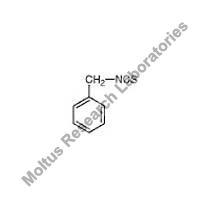
Benzyl Isothiocyanate Supplier - Our products are pre and have a higher shelf life. This is because we use international standards to offer accurate composition at all times.
0 notes
Note
*pats askbox gently* there are more Thermoreceptors?
(I'm sorry ur dome was so hot; I hope its much cooler now!)
My bluff has been called! Hooray!!
I am not a neurologist, a biologist, or a scientist. If anyone with better credentials than "obsessed with emergent properties" contradicts me, listen to them instead.
Cell membranes include little portal proteins that open under certain circumstances based on the shape of the protein and let chemicals into and out of the cell. These portals are useful for all sorts of things: managing water and nutrients, sending messages to nearby cells, serving the whims of tiny intercellular cats. Science hasn't found the tiny intercellular cats yet, but we all know they're there; the existence of a door that can be opened necessarily implies an indecisive feline.
Some protein shapes open up if the temperature is within a certain range. This means that if a cell with that sort of protein in its membrane experiences a temperature in the right range, it will move some chemicals around. This is used to make nerve cells that send a message towards the brain whenever they experience a certain temperature.
Because evolution does all its best work the night before the deadline while on a Code Red Mountain Dew bender, the opened-by-temperature portal proteins are mostly copied from opened-by-a-specific-chemical portal proteins. All of them, in fact, still open for specific chemicals, which means there exist out in the world liquids you can put in a bottle that most animals will instead perceive as "a temperature between 8 and 26 degrees" So things can get a little weird.
Temperature-opening portal proteins:

TRPA1
Opens for temperatures below 12C (not air temperature, skin or body temperature, so you might be kind of in trouble when this happens). Used by hunting snakes to detect where heat isn't so they can find prey. Feels painful in an itchy sort of way.
This one also opens for allyl isothiocyanate. Many plants have evolved to take advantage of the existence of a chemical most animals perceive as itchy pain, especially horseradish and wasabi. Allyl isothiocyanate is harmful to plants, so they keep two separate components in tiny compartments. When an animal bites the plant, the compartments break open their contents mix to create allyl isothiocyanate.
"This plant tastes like itching" is a good defense against almost all animals, but some humans have taught themselves to appreciate the taste of itching.
TRPM8
Opens for temperatures between 8 and 26 degrees. Opens for menthol (peppermint, spearmint, wintergreen) and linalool (roses, orange blossoms, basil). Feels cool or cold.
"This plant tastes like cold" is a somewhat less effective defense against being eaten than "this plant tastes like itching" but it's a more widespread defense because TRPM8-activating chemicals don't harm plants and don't need elaborate two-part storage.
TRPV4
Opens for temperatures from 27-37 C. I'm not sure what this one feels like, or if even feels like anything, since it covers normal human body temperatures. Whatever feeling we get from this one, we're feeling it nearly all the time.
Plants do make a chemical that tastes like this temperature, and it can repel nonhuman creatures with different body temperatures: allicin, the flavour of garlic. Like allyl isothiocyante, it is stored in two compartments inside the plant, and combined when the plant is bitten.
Maybe this is why vampires abhor garlic. There is a feeling that, as humans, we always have. Something we don't notice, something deeper than touch. That feel disappears forever when you become a vampire, except those unbearable moments when garlic returns to you for a fleeting moment the experience of lost humanity.
TRPV3
Opens for temperatures 33-39 degrees. Opens for eugenol, found in cinnamon, nutmeg, bay leaf, holy basil, ginger, allspice, and cloves. Feels like warmth.
Plants with high quantities of eugenol, like holy basil and Japanese star anise, are sometimes sacred to buddhists because they smell nice and bugs don't like to eat them, so you can burn them as incense without worrying about all the little crawly guys.
Humans apparently think food that tastes like "warm" is comforting.
TRPV1
Opens for temperatures over 43 degrees. (The one I was experiencing in the overheated dome, which I had never felt from air before) Opens for capsaicin, the active chemical in hot peppers. Opens for the combination of temperature and acidity of fevers and infected wounds. This one we feel as pain, as burning, as flame.
TRPV1 says: Your flesh is failing, and your doom is very near.
Humanity says: This is incredible. We are going to breed plants that cause this sensation as much as possible, and we will spend thousands of years getting it right. We are going to dry this and powder this and flake it and grill it and ferment it and eat it with everything.
And when we leave earth and go into space, we take hot peppers with us. Without gravity, fluid builds up in nasal passages, and astronauts sort of have colds the entire time they're in space and can't smell food very well. But the Nearness Of Your Doom is not a smell and is not perceived by the nose, so - with their doom always on the other side of ten centimeters of insulated aluminum - astronauts can taste hot peppers. In 2002, Peggy Whitson, commander of the ISS, jokingly refused to let a replacement crew on board until they handed over the hot sauce.
We are a strange and wonderful species.
#question#ame-kage#vampires#astronauts#intercellular cats#fun post to tag#we are growing something that affects each of these. :)#there are at least three more heat-reactive ion channels but I don't think we use them for much: TRPM3 ANO1 TRPV2
219 notes
·
View notes
Text
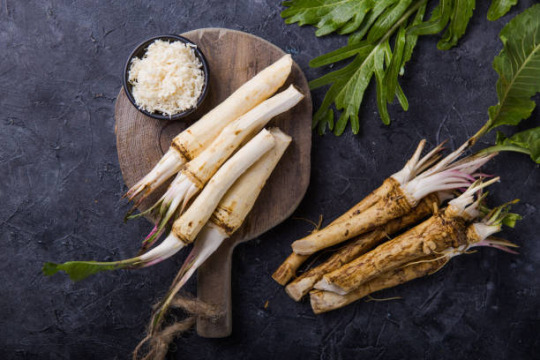
Horseradish (Armoracia rusticana, Brassicaceae - Mustard Family)
an extended version of this materia media can be found on the Patreon - where I share some gastronomic/culinary commentaries on horseradish
"The root's potent smell can be attributed to allyl isothiocyanate, or Mustard oil, which is released when the plant's skin is broken or disturbed. Similar to other members of the Brassicaceae family, this constituent is also found in Brussels sprouts, Mustard, and Turnips."
"In Greek mythology, the Delphic Oracle told Apollo, 'The Radish is worth its weight in lead, the Beet its weight in silver, the Horseradish its weight in gold.'"
"To a worm in a horseradish, the world is a horseradish” - Yiddish Proverb
Gardening: full sun to part shade; well draining loose or sandy soil; regular water; room to spread and grow deep, often takes over more space than expected; thrives even when neglected; herbaceous perennial
Native Region: Russia & Eastern Ukraine
Season: autumn and winter (hardy to zone 5)
Affinity: sinuses, lungs, digestive system, circulation
Parts: roots and leaves
Medicinal: fire cider/oxymels, cold-water infusion, succus (fresh juice), cough syrup, poultice for sprains/injuries, tincture, culinary measures
"Grated horseradish mixed with honey [or vegan alternative]. After mixing, allow to stand to take off sharp taste. The [sweetener] is only used to make it more palatable. 2/3 horse-radish and 1/3 [sweetener], or to suit the taste. The ordinary radish, especially the black radish, may also be used the same way, or finely sliced and eaten alone as a salad. For consumptives who cough without spitting, give a spoonful every once in a while." - Special "Mucus-Eliminator" Recipe in Arnold Ehret's Mucusless Diet Healing System
^I like to add grated orange peel to help make it more manageable to taste^
Actions: diuretic, stimulant, expectorant, rubefacient, aphrodisiac, digestive, antiseptic (laxative), aperient, anthelmintic, emetic (in high doses)
‼when you cut into horseradish, its pungent smell can irritate the eyes and nasal passages, so it's better to do in a well-ventilated area or outside. It is more potent in its effect than onions. The taste is also very pungent, so you don't need much.
Energetic Uses (eg. flower essence, elemental rituals): FIRE ELEMENT - balance fiery nature, excite inner fire, move you beyond sense of being stuck/helpless, shine a light on blockages, release old patterns or thoughtforms
Indications: hoarse, persistent, dry cough; rheumatism; tuberculosis; kidney stones; parasite infections; cold; congestion
Analogs: wasabi, radish, mustard, brussels sprouts, moringa (Moringa oleifera)
Traditional Uses:
Ancient Greeks & Romans: rub for lower back pain or menstrual cramps, aphrodisiac
Middle Ages: asthma, arthritis, cancer, toothaches
Jewish: bitter herb for Passover seder
Native Americans: toothaches, menstrual cramps
British: accompaniment to beef and oysters, cordials
Scurvy preventative
Treatment for tuberculosis
Restoring color and freshness to skin (cosmetic usage)
Modern Ideas:
"The enzyme horseradish peroxidase (HRP) is a useful
tool for detecting antibodies in the molecular biology field."
"In 2008, researchers reported that they had developed a fire alarm for the deaf and hard of hearing by harnessing the strong smell of horseradish."
"Researchers from Pennsylvania State University announced in 1995 that according to their studies, using horseradish may help purify wastewater and tainted soils."
Sources: a b c d e
#txt#dream garden#herbarium#horseradish#Armoracia rusticana#food centric herbalism#herbalism#gardening#materia medica#sidewalkchemistry
19 notes
·
View notes
Note
AITA for wanting to euthanize my squirrel boyfriend?
I (anteaterM) drew some blood from my boyfriend (squirrelM) while we were in my lab. I needed a test patient to assist me in drawing blood and examining it, since I don’t do it very often and I was a bit rusty, and he happily offered himself to me.
All was well while I was running my tests. However, during the CMP, I noticed he had an astoundingly high blood glucose level. He has an obsessive habit with eating sweets and desserts, so I chalked it up to that, but I decided to take a closer look just in case. What I found was not a result of sugary consumption, but nerve damage. I was both appalled and worried, and dove into more specific assessments in hopes of figuring out what was wrong with him. I ran multiple tests for likely conditions such as epilepsy, Parkinson's, strokes, and much, much more. But they all came back negative.
Then a really terrifying thought hit me. I didn’t want it to be true, and I was fairly certain it wasn't true, but I had to be 100% sure. I treated him with globulin (already conjugated with fluorescent isothiocyanate) and injected his finger with lidocaine to cut into the tip of it so I could swab some of his nervous tissue. I ran a fluorescent antibody test with it, and all my fears came true, because it turns out he has rabies.
I have no idea how this happened, or when it happened. He's always been very jittery and unpredictable but again, I assumed it was his unhealthy candy addiction. I even re-drew more blood and ran the tests a couple times to make sure I was getting accurate results. The whole time I was looking at the final product, mortified, and he was in the next room jumping around crazily without a care in the world. Earlier I asked him if he had any sicknesses or diseases, and he said no, so he has no idea he has rabies.
For a while I didn't know what to do. My boyfriend has rabies. After some extra thought, I realized what I had to do. I had to kill him. I had to put him out of his misery lest he spread his rabies to everyone in the town we live in.
I wanted to make his death quick and painless, and opted for euthanization, which he would have no knowledge of. It was either an eventual, inhumane (inanimane?) death from the rabies or that. Unfortunately, he left my lab before I could get everything set up in time because he had things to do. I vented my frustrations in a different subreddit and received tons of backlash for my "heartless" actions and considerations. How is this heartless if I am saving every animal in town from his potential wrath?
I don't want him to go either, especially since he's my boyfriend, but I figured I'd have to do what I have to do. Apparently not. AITA?
7 notes
·
View notes
Text
Meducoid Mycelium Cure
So I've had this theory for quite a while and thought I would share it. I would like to clarify that I don't have any type of high education in chemistry or biology so take this with a grain of sugar. This theory doesn't cover the sugar bowl or the apples in the arboretum.
So, as a bit of context, this theory came to be when I was doing an in depth re-watch of A Series of Unfortunate Events (Netflix) and by in depth I mean pausing at least every 5 minuets to have a debate with my friend. We noticed that at 4 points rutabagas were mentioned, and mentioning something once is fine, twice is a coincidence, thrice is suspicious and quadrice means that its important. 2 of the times rutabagas were mentioned were in areas where you had to pause to see (Rutabaga River and rutabagas mentioned in 'An Incomplete History of Secret Organisations'). the other 2 times was Esme having a basket of rutabagas and Colette (or Kevin) saying how they could start a rutabaga farm.
My first thought was that it was a substitute for horseradish but because I have no culinary knowledge (and have never had horseradish, wasabi or rutabagas so I have no idea if they even tasted similar) I went to reddit to find if they knew but I only had two answers, one person said that using rutabagas to cure the Meducoid Mycelium would be useless and the other said maybe as they are both spicy vegetables.
But I wasn't satisfied so I did my own digging.
I figured that if both horseradish and wasabi cure the Meducoid Mycelium they mush share a chemical of sort so I googled it. Apparently they share a chemical called Allyl isothiocyanate (AIT). I got this from this website. so you can judge how true this is. Also on that website it mentioned that AIT is well known to prohibit bacteria and fungal growth (this is on sentence 3, this is the direct quote 'It is well known that AIT shows inhibitory effect on the growth of food poisoning bacteria and fungi.').
I then went digging and the website is right AIT is a fungicide. Also I went digging some more about other foods with AIT in it and this is the list Wasabi, Horseradish, broccoli, radish, cabbage, mustard and other cruciferous vegetables (I got this information in this website on the first paragraph of the introduction).
so I did my final bit of research of what more examples of cruciferous vegetables and here is the final list of foods that should cure the Meducoid Mycelium: Horseradish, Land cress, Ethiopian mustard, Kale, Chinese broccoli, Cabbage, Savoy cabbage, Brussels sprouts, Kohlrabi, Broccoli, Broccolini, Broccoloflower, Broccoli romanesco, Chinese cabbage, Cauliflower, Wild broccoli, Komatsuna, Mizuna, Rapini (broccoli rabe), Choy sum (flowering cabbage), Chinese cabbage (napa cabbage), Turnip roots, Siberian kale, Canola/rapeseed, Wrapped heart mustard cabbage, Mustard seeds, White mustard seeds, Black mustard seeds, Tasoi, Wild arugula, Arugula, Field pepperweed, Maca, Garden cress, Watercress, Radish, Daikon, Wasabi and yes Rutabaga.
(this is my proof of were I got these . I know its Wikipedia but I trust it with this. )
7 notes
·
View notes
Text
@bates--boy from here
[text: Rai Bread] my man!! 🤜🤛
[text: Rai Bread] couldn't pick a better man for the job! but we can't too long cuz I want to try a chili recipe I saw online
----
[text: Pēterītis] I would be glad to help! not sure if I can eat the chili though. Me and spice aren't on friendly terms
[text: Pēterītis] well, except for horseradish or mustard spice. I can fight out the sinus-stabbign isothiocyanate, but if I have to face one (1) red pepper flake I will die to capsaicin. And t hen who will help pick produce?
[text: Pēterītis] i'm weak
4 notes
·
View notes
Text
Just thinking about molecular gastronomy shit. And I feel like name-dropping some of my fave flavor (and taste) compounds in food stuffs (lots sulfurous, pungent things... pffft.)
Like this stuff about truffles:
Sulfur volatiles, which occur in all truffle species, such as dimethyl mono- (DMS), di- (DMDS) and tri- (DMTS) sulfides, as well as 2-methyl-4,5-dihydrothiophene, characteristic of the white truffle T. borchii and 2,4-Dithiapentane occurring in all species but mostly characteristic of the white truffle T. magnatum. Some very aromatic white truffles are notably pungent, even irritating the eye when cut or sliced.
Or shit like...
Allicin - the main sulfurous compound in alliums (onions, garlic, shallots, scallions, etc.) It's just SO good, man.
Allyl isothiocyanate - the pungent undertone of all things from the mustard family (cabbage, broccoli, horseradish... and many others.)
Gingerol - I love the shit outta ginger man. It's got that BITE to it.
Capsaicin - Look. I LOVE getting those TRPV1 receptors firing, man.
Raspberry ketone - Something far less noxious/bite-y but i just love this aspect in the Rubus genus... so so so much. (I couldn't help but mention this in the Promethean!Logan drabble.)
All the shit that gives coffee it's profile. There's some overlaps with chocolate here too. (Like many other experiences - it's usually ALWAYS gonna be an absolute bouquet of VOCs.)
2 notes
·
View notes
Text
KELOR

Kelor atau merunggai memiliki nama ilmiah Moringa oleifera. Tanaman kelor merupakan jenis tanaman tropis.
A. CIRI-CIRI
Tanaman kelor dapat dikenali dengan ciri-ciri sebagai berikut :
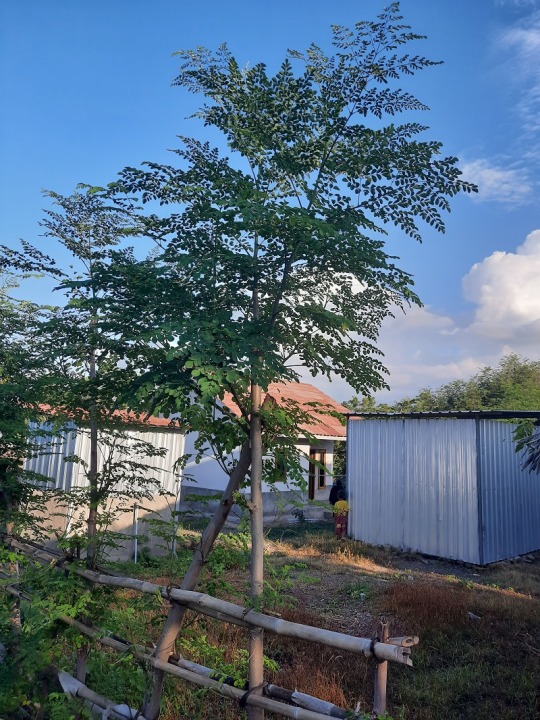
Tinggi tanaman kelor sekitar 7-11 meter, dan diameternya sekitar 30cm
Ukuran daunnya kecil-kecil, yang tersusun teratur dalam satu tangkai pohon
Bentuk daunnya bulat telur, dengan panjang 1-3 cm, lebar 4mm - 1 cm, ujung daun tumpul, pangkal daun membulat, dan tepi daun rata
Bunganya berwarna putih kekuningan kuningan, dan tudung pelepah bunganya berwarna hijau
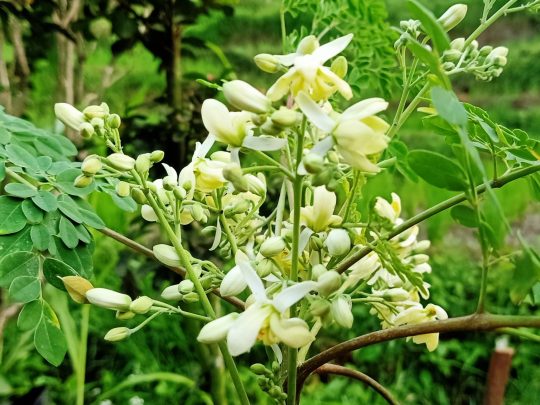
5. Buah tanaman kelor berbentuk segitiga memanjang

6. Karakteristik daun kelor adalah bersirip tak sempurna, dengan ukuran kecil sebesar ujung jari
7. Helaian anak daunnya berwarna hijau sampai hijau kecoklatan
B. KLASIFIKASI
Tanaman kelor memiliki klasifikasi sebagai berikut :
Kingdom : Plantae
Divisio : Magnoliophyta
Class : Magnoliopsida
Ordo : Brassicales
Famili : Moringaceae
Genus : Moringa
Spesies : Moringa oleifera L.
C. KANDUNGAN
Kandungan-kandungan yang terdapat pada tanaman daun kelor contohnya :
Argine
Histidine
Isoleucine
Leusine
Lysine
Methionine
Phenylaline
Threonine
Thryptopan
Valine
Senyawa isotiosianat dan glukosinolat
Senyawa antioksidan untuk melawan radikal bebas dalam tubuh
Memiliki banyak nutrisi bagi tubuh seperti, vitamin A, vitamin B, Zat besi, dan masih banyak lagi
Sumber vitamin C yang berguna untuk mencegah penyakit kronis
Anti inflamasi
Senyawa fenolik, flavonoid, betakaroten, zeaxanthin, tain dan Lutein yang bermanfaat untuk kesehatan mata
Selain kandungan-kandungan yang disebutkan di atas, masih banyak lagi kandungan-kandungan tanaman kelor lainnya yang memberikan banyak sekali manfaat bagi kita.
D. MANFAAT BAGI KESEHATAN
Tanaman kelor memiliki banyak sekali manfaat sehingga disebut sebagai Mega superfood/tanaman fungsional, karena bagian-bagian tumbuhannya mulai dari daun, bunga, hingga buah dapat dimanfaatkan menjadi obat ataupun dikonsumsi sebagai sayuran. Berikut ini adalah manfaat tanaman kelor bagi kesehatan :
Menurunkan kadar gula darah, karena daun kelor mengandung asam klorogenik
Mengurangi peradangan, karena daun kelor mengandung isothiocyanate atau senyawa anti inflamasi
Menangkal radikal bebas, karena daun kelor mengandung antioksidan yang tinggi
Menurunkan tekanan darah, karena mengandung Quercetin yang merupakan antioksidan kuat
Mendukung kesehatan otak, karena daun kelor mengandung vitamin E dan C yang tinggi melawan oksidasi yang mengarah pada degenerasi neuron
Mencegah kanker, daun kelor mengandung antioksidan yang tinggi sehingga dapat membunuh sel yang telah mati dan mencegah tumbuhnya sel kanker
Meningkatkan produksi asi
Mengurangi gejala menopause, karena daun kelor mengandung banyak vitamin dan mineral
Menjaga kesehatan kulit, seperti mencegah penuaan dini, dan mengobati jerawat
Bunga daun kelor bermanfaat sebagai obat stimulan, afrodisiak, abortifacient, cholagogue, digunakan untuk menyembuhkan radang, penyakit otot, dan lain sebagainya
Buah daun kelor sering diolah menjadi makanan, seperti sayur bening, sayur santan, dan sayur asem
E. PENGAPLIKASIAN PADA MAKANAN
Donat daun kelor
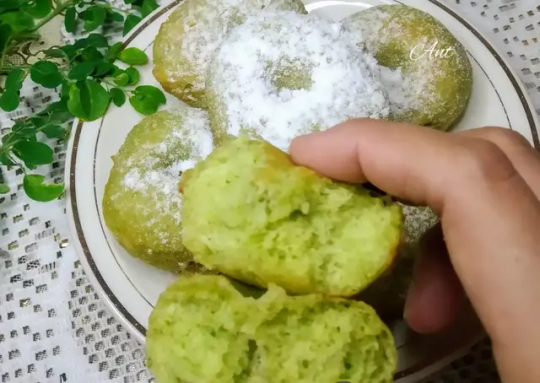
2. Sayur bening

F. CARA MENANAM
Karakteristik lahan yang baik digunakan :
Terkena cahaya matahari langsung minimal 6 jam sehari
Dekat dengan sumber air
Mengandung unsur hara yang cukup
2. Memilih lahan dengan tanah yang subur, agar dapat tumbuh maksimal
3. Lakukan pembersihan hama pada lahan sebelum mulai penanaman
4. Buatlah lubang dengan diameter sekitar 50-70 cm, dengan kedalaman sekitar 50 cm
5. Gunakan pupuk organik sebagai pupuk dasarnya, cara pemberian pupuk ini adalah masukan pupuk organik secukupnya ke dalam lubang kemudian tutup dengan tanah sampai 3/4 bagian, setelah itu kita dapat membiarkan lubang minimal 2 minggu agar keadaan pupuk dalam tanah dapat terurai terlebih dahulu.
6. Lalu tanam tanaman kelor, dan sirami secara teratur
G. SUMBER REFERENSI
https://ccrc.farmasi.ugm.ac.id/ensiklopedia/ensiklopedia-tanaman-antikanker/k/kelor-moringa-oleifera-l/
3 notes
·
View notes
Text
Dimethylphenyl Isothiocyanate supplier
Dimethylphenyl Isothiocyanate Supplier - Moltus Research Laboratories Pvt. Ltd is one of the sought-after names for industrial chemicals. We are a leading manufacturer, exporter, and supplier of Dimethylphenyl Isothiocyanate.
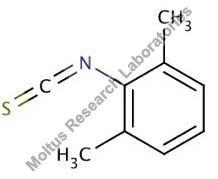
0 notes
Text
i can’t get a clear answer on whether or not birds are able to taste the spice of mustards like wasabi or horseradish bcuz the spicy element in them is allyl isothiocyanate instead of capsaicin like in peppers, but anyways; Cardassians that can’t detect capsaicin and so Garak likes to be a dick at lunch sometimes and eat ultra insane level spicy foods in front of Julian and offer him some knowing Julian will turn it down but then one day he decides to get something with wasabi and knowing it’s spicy, piles a mashed potato sized glob on and then he takes a bite and knows Regret
16 notes
·
View notes
Text
Turns out the witches in Macbeth were just brewing a cocktail of poisons.
Eye of newt is mustard seed; if you boil it too long you get a skin irritant, isothiocyanate.
Toe of frog is buttercup, which is known for killing horses.
Wool of bat is holly leaves, which cause vomiting, diarrhea, and drowsiness.
Tongue of dog is (not exactly surprisingly) houndstongue, which kills cows.
Adders fork is adder’s tongue, presumably the arum lily (of the many plants called “adder’s tongue”), the berries of which are lethally toxic to children (and the roots of which produce a skin irritant).
13 notes
·
View notes